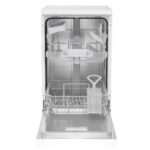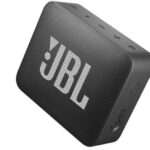BOSCH UniversalChain 18 User Manual
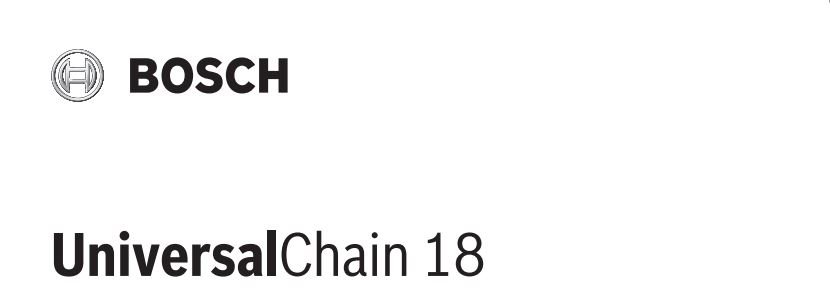
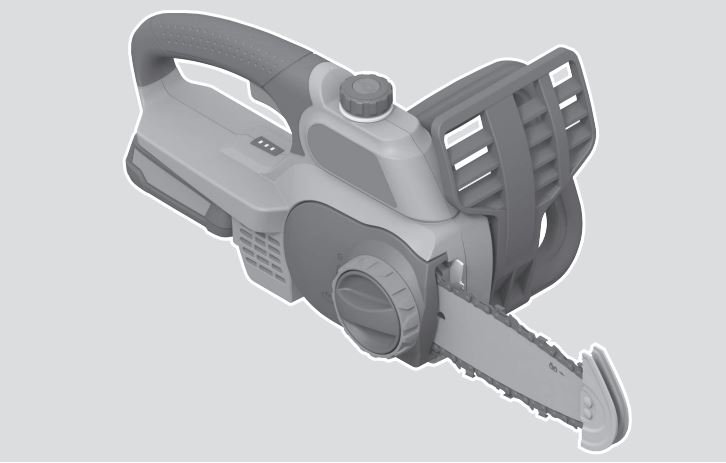
Safety Notes
Explanation of symbols
 Read instruction manual.
Read instruction manual.
 Do not expose to rain.
Do not expose to rain.
 WARNING: Keep bystanders away.
WARNING: Keep bystanders away.
 Always hold a chain saw firmly with both hands.
Always hold a chain saw firmly with both hands.
 Pay attention to the kickback of the chainsaw and avoid contact with the tip of the chain bar.
Pay attention to the kickback of the chainsaw and avoid contact with the tip of the chain bar.
 Wear eye and head protection.
Wear eye and head protection.
 Wear slip-resistant footwear.
Wear slip-resistant footwear.
 Wear hand protection
Wear hand protection
 Remove battery before adjusting, transporting or cleaning, and before leaving the machine unattended for any period.
Remove battery before adjusting, transporting or cleaning, and before leaving the machine unattended for any period.
General Power Tool Safety Warnings
⚠️WARNING
Read all safety warnings, instructions, illustrations and specifications provided with this power tool. Failure to follow all instructions listed below may result in electric shock, fire and/ or serious injury.
Save all warnings and instructions for future reference. The term “power tool” in the warnings refers to your mainsoperated (corded) power tool or battery-operated (cordless) power tool.
Work area safety
- Keep work area clean and well lit. Cluttered or dark areas invite accidents.
- Do not operate power tools in explosive atmospheres, such as in the presence of flammable liquids, gases or dust. Power tools create sparks which may ignite the dust or fumes.
- Keep children and bystanders away while operating a power tool. Distractions can cause you to lose control.
Electrical safety
- Power tool plugs must match the outlet. Never modify the plug in any way. Do not use any adapter plugs with earthed (grounded) power tools. Unmodified plugs and matching outlets will reduce risk of electric shock.
- Avoid body contact with earthed or grounded surfaces, such as pipes, radiators, ranges and refrigerators. There is an increased risk of electric shock if your body is earthed or grounded.
- Do not expose power tools to rain or wet conditions. Water entering a power tool will increase the risk of electric shock.
- Do not abuse the cord. Never use the cord for carrying, pulling or unplugging the power tool. Keep cord away from heat, oil, sharp edges or moving parts. Damaged or entangled cords increase the risk of electric shock.
- When operating a power tool outdoors, use an extension cord suitable for outdoor use. Use of a cord suitable for outdoor use reduces the risk of electric shock.
- If operating a power tool in a damp location is unavoidable, use a residual current device (RCD) protected supply. Use of an RCD reduces the risk of electric shock.
Personal safety
- Stay alert, watch what you are doing and use common sense when operating a power tool. Do not use a power tool while you are tired or under the influence of drugs, alcohol or medication. A moment of inattention while operating power tools may result in serious personal injury.
- Use personal protective equipment. Always wear eye protection. Protective equipment such as a dust mask, non-skid safety shoes, hard hat or hearing protection used for appropriate conditions will reduce personal injuries.
- Prevent unintentional starting. Ensure the switch is in the off-position before connecting to power source and/or battery pack, picking up or carrying the tool. Carrying power tools with your finger on the switch or energising power tools that have the switch on invites accidents.
- Remove any adjusting key or wrench before turning the power tool on. A wrench or a key left attached to a rotating part of the power tool may result in personal injury.
- Do not overreach. Keep proper footing and balance at all times. This enables better control of the power tool in unexpected situations.
- Dress properly. Do not wear loose clothing or jewellery. Keep your hair and clothing away from moving parts. Loose clothes, jewellery or long hair can be caught in moving parts.
- If devices are provided for the connection of dust extraction and collection facilities, ensure these are connected and properly used. Use of dust collection can reduce dust-related hazards.
- Do not let familiarity gained from frequent use of tools allow you to become complacent and ignore tool safety principles. A careless action can cause severe injury within a fraction of a second.
Power tool use and care
- Do not force the power tool. Use the correct power tool for your application. The correct power tool will do the job better and safer at the rate for which it was designed.
- Do not use the power tool if the switch does not turn it on and off. Any power tool that cannot be controlled with the switch is dangerous and must be repaired.
- Disconnect the plug from the power source and/or remove the battery pack, if detachable, from the power tool before making any adjustments, changing accessories, or storing power tools. Such preventive safety measures reduce the risk of starting the power tool accidentally.
- Store idle power tools out of the reach of children and do not allow persons unfamiliar with the power tool or these instructions to operate the power tool. Power tools are dangerous in the hands of untrained users.
- Maintain power tools and accessories. Check for misalignment or binding of moving parts, breakage of parts and any other condition that may affect the power tool’s operation. If damaged, have the power tool repaired before use. Many accidents are caused by poorly maintained power tools.
- Keep cutting tools sharp and clean. Properly maintained cutting tools with sharp cutting edges are less likely to bind and are easier to control.
- Use the power tool, accessories and tool bits etc. in accordance with these instructions, taking into account the working conditions and the work to be performed. Use of the power tool for operations different from those intended could result in a hazardous situation.
- Keep handles and grasping surfaces dry, clean and free from oil and grease. Slippery handles and grasping surfaces do not allow for safe handling and control of the tool in unexpected situations.
Battery tool use and care
- Recharge only with the charger specified by the manufacturer. A charger that is suitable for one type of battery pack may create a risk of fire when used with another battery pack.
- Use power tools only with specifically designated battery packs. Use of any other battery packs may create a risk of injury and fire.
- When battery pack is not in use, keep it away from other metal objects, like paper clips, coins, keys, nails, screws or other small metal objects, that can make a connection from one terminal to another. Shorting the battery terminals together may cause burns or a fire.
- Under abusive conditions, liquid may be ejected from the battery; avoid contact. If contact accidentally occurs, flush with water. If liquid contacts eyes, additionally seek medical help. Liquid ejected from the battery may cause irritation or burns.
- Do not use a battery pack or tool that is damaged or modified. Damaged or modified batteries may exhibit unpredictable behaviour resulting in fire, explosion or risk of injury.
- Do not expose a battery pack or tool to fire or excessive temperature. Exposure to fire or temperature above 130°C may cause explosion.
- Follow all charging instructions and do not charge the battery pack or tool outside the temperature range specified in the instructions. Charging improperly or at temperatures outside the specified range may damage the battery and increase the risk of fire.
Service
- Have your power tool serviced by a qualified repair person using only identical replacement parts. This will ensure that the safety of the power tool is maintained.
- Never service damaged battery packs. Service of battery packs should only be performed by the manufacturer or authorized service providers.
General Chain Saw Safety Warnings
- Keep all parts of the body away from the saw chain when the chain saw is operating. Before you start the chain saw, make sure the saw chain is not contacting anything. A moment of inattention while operating chain saws may cause entanglement of your clothing or body with the saw chain.
- Always hold the chain saw with your right hand on the rear handle and your left hand on the front handle. Holding the chain saw with a reversed hand configuration increases the risk of personal injury and should never be done.
- Hold the chain saw by insulated gripping surfaces only, because the saw chain may contact hidden wiring. Saw chains contacting a “live” wire may make exposed metal parts of the chain saw “live” and could give the operator an electric shock.
- Wear eye protection. Further protective equipment for hearing, head, hands, legs and feet is recommended. Adequate protective clothing will reduce personal injury from flying debris or accidental contact with the saw chain.
- Do not operate a chain saw in a tree, on a ladder, from a rooftop, or any unstable support. Operation of a chain saw in this manner could result in serious personal injury.
- Always keep proper footing and operate the chain saw only when standing on fixed, secure and level surface. Slippery or unstable surfaces such as ladders may cause a loss of balance or control of the chain saw.
- When cutting a limb that is under tension be alert for spring back. When the tension in the wood fibres is released the spring loaded limb may strike the operator and/or throw the chain saw out of control.
- Use extreme caution when cutting brush and saplings. The slender material may catch the saw chain and be whipped toward you or pull you off balance.
- Carry the chain saw by the front handle with the chain saw switched off and away from your body. When transporting or storing the chain saw, always fit the guide bar cover. Proper handling of the chain saw will reduce the likelihood of accidental contact with the moving saw chain.
- Follow instructions for lubricating, chain tensioning and changing the bar and chain. Improperly tensioned or lubricated chain may either break or increase the chance for kickback.
- Cut wood only. Do not use chain saw for purposes not intended. For example: For example: do not use chain saw for cutting metal, plastic, masonry or non-wood building materials. Use of the chain saw for operations different than intended could result in a hazardous situation.
- This chain saw is not intended for tree felling. Use of the chain saw for operations different than intended could result in serious injury to the operator or bystanders.
- Follow all instructions when clearing jammed material, storing or servicing the chain saw. Make sure the switch is off and the battery pack is removed. Unexpected actuation of the chain saw while clearing jammed material or servicing may result in serious personal injury.
- Causes and operator prevention of kickback:
– Kickback may occur when the nose or tip of the guide bar touches an object, or when the wood closes in and pinches the saw chain in the cut.
– Tip contact in some cases may cause a sudden reverse reaction, kicking the guide bar up and back towards the operator.
– Pinching the saw chain along the top of the guide bar may push the guide bar rapidly back towards the operator.
– Either of these reactions may cause you to lose control of the saw which could result in serious personal injury. Do not rely exclusively upon the safety devices built into your saw. As a chain saw user, you should take several steps to keep your cutting jobs free from accident or injury.
Kickback is the result of tool misuse and/or incorrect operating procedures or conditions and can be avoided by taking proper precautions as given below: - Maintain a firm grip, with thumbs and fingers encircling the chain saw handles, with both hands on the saw and position your body and arm to allow you to resist kickback forces. Kickback forces can be controlled by the operator, if proper precautions are taken. Do not let go of the chain saw.
- Do not overreach and do not cut above shoulder height. This helps prevent unintended tip contact and enables better control of the chain saw in unexpected situations.
- Only use replacement bars and chains specified by the manufacturer. Incorrect replacement bars and chains may cause chain breakage and/or kickback.
- Follow the manufacturer’s sharpening and maintenance instructions for the saw chain. Decreasing the depth gauge height can lead to increased kickback.
Additional safety warnings
- It is recommended that the first time user should have practical instruction in the use of the chainsaw and the protective equipment from an experienced operator. The initial practice should be cutting logs on a saw horse or cradle.
- This appliance is not intended for use by persons (including children) with reduced physical, sensory or mental capabilities, or lack of experience and knowledge, unless they have been given supervision or instruction concerning use of the appliance by a person responsible for their safety. Children should be supervised to ensure that they do not play with the appliance.
- Children and juveniles, with the exception of apprentices older than 16 years and under supervision, may not operate the chain saw. The same applies for persons who do not or do not sufficiently know how to handle the chain saw. The operating instructions should always be ready to hand. Persons unfit or tired must not operate the chain saw.
- When working with the machine, always hold it firmly with both hands and provide for a secure stance. The power tool is guided more secure with both hands.
- Always ensure all handles and guards are fitted when using the machine. Never attempt to use an incomplete machine or one fitted with an unauthorized modification.
- Always wait until the machine has come to a complete stop before placing it down. The tool insert can jam and lead to loss of control over the power tool.
- Always operate the power tool with a properly aligned and tensioned chain. Using the power tool with a misaligned or incorrectly tensioned chain can result in chain breakage, kickback and/or injury.
- Always make sure that the chain is in the correct position. An incorrectly positioned chain can result in chain breakage, kickback and/or injury.
Safety Instructions and Recommendations for Optimal Handling of the Battery
- Ensure the product is switched off before inserting the battery. Inserting the battery into a product that has the switch on can cause accidents.
- Use only Bosch batteries intended specifically for this product. Use of any other batteries may create a risk of injury and fire.
- Do not open the battery. There is a risk of short-circuiting.
 Protect the battery against heat (e.g., against continuous intense sunlight), fire, water, and moisture. There is a risk of explosion.
Protect the battery against heat (e.g., against continuous intense sunlight), fire, water, and moisture. There is a risk of explosion. - Keep the battery not being used away from paper clips, coins, keys, nails, screws or other small metal objects, that can make a connection from one terminal to another. Shorting the battery terminals together may cause burns or a fire.
- In case of damage and improper use of the battery pack, vapours may be emitted. Ventilate the area and seek medical help in case of complaints. The vapours can irritate the respiratory system.
- Only use the battery with products from the manufacturer. This is the only way in which you can protect the battery against dangerous overload.
- The battery can be damaged by pointed objects such as nails or screwdrivers or by force applied externally. An internal short circuit may occur, causing the battery to burn, smoke, explode or overheat.
- Do not short-circuit the battery. There is a risk of explosion.
- Protect the battery against moisture and water.
- Store the product and battery only within a temperature range between –20 °C and 50 °C . As an example, do not leave the battery in the car in summer.
- Occasionally clean the venting slots of the battery using a soft, clean and dry brush.
Safety Warnings for Battery Chargers
 Read all safety warnings and all instructions. Failure to follow the safety warnings and instructions may result in electric shock, fire and/or serious injury.
Read all safety warnings and all instructions. Failure to follow the safety warnings and instructions may result in electric shock, fire and/or serious injury.
Save all safety warnings and instructions for future reference.
Use the battery charger only when you fully understand and can perform all functions without limitation, or have received appropriate instructions.
- Never allow children, persons with physical, sensory or mental limitations or a lack of experience and/or knowledge and/or people unfamiliar with these instructions to use the battery charger. Local regulations may restrict the age of the operator.
- Supervise children at all times. This will ensure that children do not play with the battery charger.
- Charge only Bosch lithium-ion batteries with a capacity above 1.5 Ah (5 battery cells or more). The battery voltage must match the battery charging voltage of the charger. Do not charge non-rechargeable batteries. Otherwise there is a danger of fire and explosion.
 Keep the battery charger away from rain or moisture. Penetration of water in the battery charger increases the risk of an electric shock.
Keep the battery charger away from rain or moisture. Penetration of water in the battery charger increases the risk of an electric shock.
- Keep the charger clean. Dirt poses a risk of electric shock.
- Always check the charger, cable and plug before use. Stop using the charger if you discover any damage. Do not open the charger yourself, and have it repaired only by a qualified specialist using only original replacement parts. Damaged chargers, cables and plugs increase the risk of electric shock.
- Do not operate the charger on an easily ignited surface (e.g. paper, textiles, etc.) or in a flammable environment. There is a risk of fire due to the charger heating up during operation.
- Do not cover the ventilation slots of the battery charger. Otherwise, the battery charger can overheat and no longer operate properly.
- For increased electrical safety, we recommend using a residual current device with a max. tripping current of 30 mA. Before using, always check your residual current device.
Symbols
The following symbols are important for reading and understanding the original instructions. Please take note of the symbols and their meaning. The correct interpretation of the symbols will help you to use the product in a better and safer manner.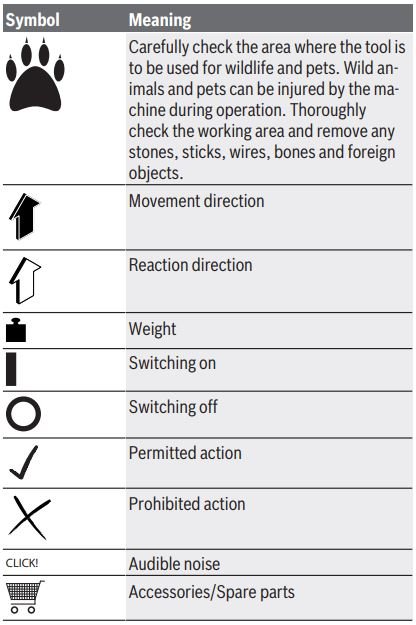
Product description and specifications
 Read all safety warnings and all instructions. Failure to follow the safety warnings and instructions may result in electric shock, fire and/or serious injury.
Read all safety warnings and all instructions. Failure to follow the safety warnings and instructions may result in electric shock, fire and/or serious injury.
Please observe the illustrations at the ending of this operating manual.
Intended Use
The power tool is used for sawing trees and tree trunks near the ground. Cuts can be sawed with or across the grain. This power tool is not suitable for sawing mineral materials. This power tool is not intended for felling trees.
Delivery Scope
Carefully remove the machine from its packaging and check if the following parts are complete:
– Chain saw
– Cover
– Saw chain
– Chain bar
– Chain guard
– Chain saw oil
– Operating instructions
Battery and charger are included in certain executions.
When parts are missing or damaged, please contact your dealer.
Product Features
The numbering of the product features refers to the diagram of the power tool on the graphics page.
- Rear handle (insulated gripping surface)
- On/Off switch
- Lock-off button for On/Off switch
- Oil filler cap
- Front handle (insulated gripping surface)
- Hand guard
- Oil level gauge
- Gripping teeth
- Chain guard
- Tip protector
- Chain bar
- Saw chain
- Chain-tensioning ring (red)
- Clamping knob
- Cover
- Battery charge-control indicator
- Battery
- Battery unlocking buttona)
- Fastening bolt
- Drive sprocket
- Oil outlet
- Oil seal
a) country specific Accessories shown or described are not included with the product as standard. You can find the complete selection of accessories in our accessories range.
Technical Data A) Electronic run-down brake
A) Electronic run-down brake
B) Depends on battery in use
C) Limited performance at temperatures <0 °C
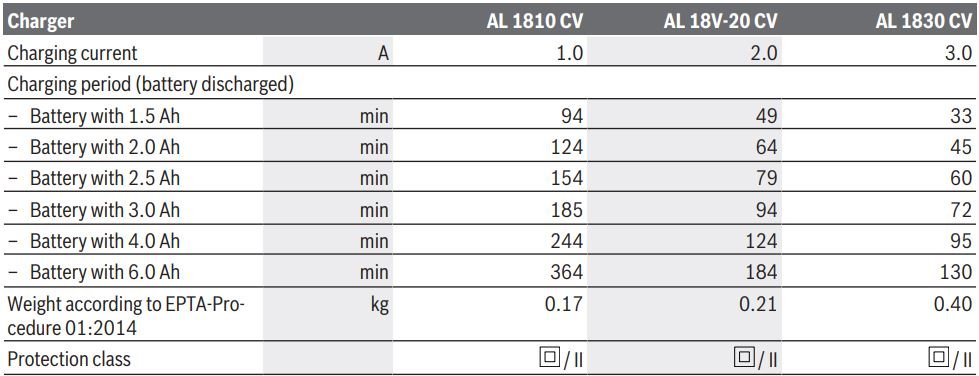
The specifications apply to a rated voltage [U] of 230 V. These specifications may vary at different voltages and in country-specific models.
Noise/Vibration Information
 That the declared vibration total value(s) and the declared noise emission value(s) have been measured in accordance with a standard test method any may be used for comparing one tool to another.
That the declared vibration total value(s) and the declared noise emission value(s) have been measured in accordance with a standard test method any may be used for comparing one tool to another.
That the declared vibration total value(s) and the declared noise emission value(s) may also be used in a preliminary assessment of exposure.
That the vibration and noise emissions during actual use of the power tool can differ from the declared values depending on the ways in which the tool is used especially what kind of workpiece is processed; and of the need to identify safety measures to protect the operator that are based on an estimation of the exposure measures in the actual conditions of use (taking account of all parts of the operating cycle such as the times when the tool is switched off and when it is running idle in addition to the trigger time).
Assembly
For Your Safety
- Warning! Switch off and remove battery from power tool before adjusting or cleaning.
- Caution! Do not touch the rotating chain.
- Do not operate the chain saw near other people, children or animals. Do not operate the chain saw after drinking alcohol or under the influence of intoxicating drugs or medication.
Inserting/removing the battery (see figure C)
Note: Using unsuitable batteries can lead to malfunctions or damage the machine. Insert the charged battery (17). Make sure that the battery is fully fitted. To remove the battery (17) from the machine, press the battery unlocking button (18) and pull the battery out.
Charging the Battery
- Observe the correct mains voltage! The voltage of the power supply must correspond with the data given on the nameplate of the battery charger. Battery chargers marked with 230 V can also be operated with 220 V.
The battery is equipped with temperature monitoring that allows charging only in the temperature range between 0 °C and 35 °C. In this manner, a high battery service life is achieved.
Note: The battery is supplied partially charged. To ensure full battery capacity, completely charge the battery in the battery charger before using for the first time.
The lithium-ion battery can be charged at any time without reducing its service life. Interrupting the charging procedure does not cause damage to the battery.
The “Electronic Cell Protection (ECP)” protects the lithiumion battery against deep discharging. When the battery is empty, the product is switched off by means of a protective circuit: The product no longer operates.
Do not continue to press the On/Off switch after an automatic shut-off of the product. The battery could become damaged.
Observe the notes for disposal of the battery.
Charging Procedure
The charging procedure starts as soon as the mains plug of the charger is plugged into a socket outlet and the battery (17) is inserted in to the charger
Due to the intelligent charging method, the charging condition of the battery is automatically detected and the battery is charged with the optimum charging current, depending on battery temperature and voltage.
This gives longer life to the battery and always leaves it fully charged when kept in the charger for storage.
Meaning of the Indication Elements (AL 1810 CV)
Flashing battery charge indicator
 The charging process is indicated by the flashing of the battery charge indicator .
The charging process is indicated by the flashing of the battery charge indicator .
Solid light on battery charge indicator
 A solid light on the battery charge indicator signals that the battery is fully charged or that the temperature of the battery is not within the permitted charging temperature range, and can therefore not be charged. The battery is charged as soon as the allowable charging temperature range is reached. When the battery is not inserted, a solid light on the battery charge indicator signals that the mains plug is inserted in the plug socket and that the charger is ready for operation.
A solid light on the battery charge indicator signals that the battery is fully charged or that the temperature of the battery is not within the permitted charging temperature range, and can therefore not be charged. The battery is charged as soon as the allowable charging temperature range is reached. When the battery is not inserted, a solid light on the battery charge indicator signals that the mains plug is inserted in the plug socket and that the charger is ready for operation.
Meaning of the Indication Elements (AL 1830 CV)
(Fast) Flashing of the Green Battery Charge Indicator
![]() The rapid-charging procedure is indicated by fast flashing of the green battery charge indicator .
The rapid-charging procedure is indicated by fast flashing of the green battery charge indicator .
Note: The rapid-charging procedure is only possible when the battery temperature is within the allowable charging temperature range, see section “Technical Data”.
(Slow) Flashing of the Green Battery Charge Indicator
![]() When the charging condition of the battery is 80%, the green battery charge indicator flashes slowly. The battery can be removed for immediate use.
When the charging condition of the battery is 80%, the green battery charge indicator flashes slowly. The battery can be removed for immediate use.
Continuous Lighting of the Green Battery Charge Indicator
![]() Continuous lighting of the green battery charge indicator indicates that the battery is fully charged. When the battery is not inserted, continuous lighting of the battery charge indicator indicates that the mains plug is inserted in the socket outlet and that the battery charger is ready for operation.
Continuous lighting of the green battery charge indicator indicates that the battery is fully charged. When the battery is not inserted, continuous lighting of the battery charge indicator indicates that the mains plug is inserted in the socket outlet and that the battery charger is ready for operation.
Continuous Lighting of the Red Battery Charge Indicator
![]() Continuous lighting of the red battery charge indicator indicates that the temperature of the battery is not within the allowable charging temperature range, see section “Technical Data”. As soon as the allowable charging temperature range is reached, the battery charger automatically switches to rapid charging.
Continuous lighting of the red battery charge indicator indicates that the temperature of the battery is not within the allowable charging temperature range, see section “Technical Data”. As soon as the allowable charging temperature range is reached, the battery charger automatically switches to rapid charging.
Flashing Red Battery Charge Indicator
![]() A flashing red battery charge indicator indicates a different malfunction of the charging procedure, see section “Troubleshooting – Causes and Corrective Measures”.
A flashing red battery charge indicator indicates a different malfunction of the charging procedure, see section “Troubleshooting – Causes and Corrective Measures”.
Charging Advice
With continuous or several repetitive charging cycles without interruption, the charger can warm up. This is not meaningful and does not indicate a technical defect of the battery charger.
A significantly reduced working period after charging indicates that the battery is used and must be replaced. Observe the notes for disposal.
Mounting and Tensioning the Chain Saw
- Do not connect the chain saw to mains before it is completely assembled.
- Always wear protective gloves when handling the chain. Chain and chain bar assembly (see figures A1–A4)
- Use only chains with a drive link thickness of 1.1 mm.
– Unpack all parts carefully.
– Place the chain saw on any suitable flat surface.
– Slide the saw chain (12) in the slot around the chain bar (11). Ensure the saw chain is in the correct running direction by comparing the saw chain with the rotation symbol.
– Fit the chain links around the drive sprocket (20) and mount the chain bar (11).
– Check if all parts are seated properly and hold the chain bar and the chain in this position.
– Reattach the cover again (15).
– Lightly tighten the cover (15) with the clamping knob (14).
– The chain is not yet tensioned. The saw chain is tensioned as described in section “Tensioning the Saw Chain”.
Tensioning the Saw Chain (see figure B)
Always check the chain tension before use, after the first cuts and regularly during use approx. every 10 minutes. Upon initial operation, new chains can lengthen considerably.
The chain life of the saw chain mainly depends upon sufficient lubrication and correct tensioning.
Avoid tensioning the chain if it is hot, as this will cause the chain to become overtensioned and fit too tightly against the chain bar when it cools down.
– Place the chain saw on any suitable flat surface.
– Turn clamping knob (14) approx. 1–3 turns anticlockwise to loosen the chain bar.
– Check if the chain links are correctly located in the slot around the chain bar (11) and on the drive sprocket (20).
– Turn the red chain-tensioning ring (13) clockwise ratcheting until the correct chain tension is reached. The ratchet mechanism prevents the chain tension from loosening. If the chain-tensioning ring (13) is hard to turn, loosen the clamping knob (14) further in anticlockwise direction. The clamping knob (14) may also turn, when adjusting the chain-tensioning ring (13).
– The saw chain (12) is correctly tensioned when it can be raised approx. 2–3 mm from the chain bar in the centre. This should be done by using one hand to raise the saw chain against the weight of the machine.
– If the saw chain (12) is overtensioned, turn the chain-tensioning ring (13) in anticlockwise direction.
– When the chain (12) is tensioned, clamp the chain bar (11) by turning the clamping knob (14) in clockwise direction. Do not use a tool for this.
Saw chain lubrication (see figure D)
Note: The chain saw is not supplied filled with chain saw oil (delivery scope). It is essential to fill with oil before use. Operating the chain saw without chain oil or when the oil level is below the minimum mark will result in damage to the chain saw.
Saw chain life and cutting capacity depend on optimum lubrication. Therefore, the chain is automatically lubricated with chain oil during operation via the oil outlet (21).
Filling the oil reservoir:
– Set chain saw on any suitable surface with the oil filler cap (4) facing upward.
– Clean area around the oil filler cap (4) with a cloth and unscrew the cap.
– Add Bosch biodegradable chain saw oil until oil level reads “max” on oil level gauge (7).
– Avoid dirt or debris from entering the oil reservoir. Screw on oil filler cap (4) again and tighten.
– Run chain saw for 30 seconds to prime oil system.
Note: To allow venting of the oil reservoir, small breather channels are provided in the oil filler cap. To prevent leakage, ensure the chain saw is left in a horizontal position (oil filler cap (4) uppermost) when not in use.
Note: It is important to use only readily biodegradable chain lubricants (according to RAL-UZ 48) to avoid damage to the chain saw. Never use recycled/old oil. Use of non approved oil will invalidate the warranty.
Note: Oil becomes denser at lower temperatures which decreases the flow rate of oil.
Operation
Inserting the battery
Insert the charged battery (17). Make sure that the battery is fully fitted.
Switching On and Off
Hold the chain saw as described in section “Working with the Chain Saw”.
To start the machine, first push the lock-off button for the On/Off switch (3) and then press the On/Off switch (2) and keep it pressed.
When the machine is running, the lock-off button can be released again. To switch off the power tool, release the On/Off switch (2).
Note: For safety reasons, the On/Off switch (2) cannot be locked; it must remain pressed during the entire operation.
Working with the Chain Saw
Before Cutting
Before starting operation and periodically during cutting, carry out the following checks:
– Is the chain saw in a fail-safe condition?
– Is the oil reservoir filled? Check oil level gauge prior to starting and regularly during operation. Refill oil when oil level has reached the bottom edge of the viewing glass. The oil tank filling will last approx. 15 minutes, depending on sawing intensity and stops.
– Is the saw chain properly tensioned and sharp? Check chain tension every 10 minutes during operation. Upon initial operation, new chains can lengthen considerably. The condition of the chain influences the cutting performance. Only a sharp chain protects from overload.
– Are you wearing the required protective equipment? Wear safety glasses and hearing protection. Further protective equipment for head, hands, legs and feet is recommended. Suitable protective clothing reduces the danger of injury from thrown about cutting material and accidental touching of the saw chain.
– Use a protective mask when cutting treated wood.
– Check if there is a power cable in the cutting area.
Kickback
Never remove or alter the tip protector! The saw is equipped with a tip protector to prevent kickback if the tip of the saw is accidentally pressed against the wood.
Kickback is the sudden backward/upward motion of the chain saw, occurring when the chain (at the tip of the chain bar) comes in contact with a log or wood, or when the chain becomes jammed.
When kickback occurs, the chainsaw reacts unpredictable and can cause heavy injuries to the operator or bystanders. Particular attention must be given when sawing sidewards, slanted or during length cuts, as the gripping teeth (8) usually can not be applied.
To avoid kickback:
– Saw with the chain bar at a flat angle.
– Never work with a loose, widely stretched or heavily worn out saw chain.
– Remove the blunt saw chain.
– Never saw above shoulder height.
– Never work with the tip of the chain.
– Always hold a chain saw firmly with both hands.
– Always use a Bosch approved low-kickback saw chain.
– Apply the metal gripping teeth (8) for leverage.
– Ensure correct chain tension.
General Behaviour (see figures E–G)
Always hold the chain saw firmly with both hands. Front handle with the left hand and rear handle with the right hand. Fully grip both handles with thumb and fingers at all times during operation. Never operate chain saw using only one hand.
Use the chain saw only with secure footing. Hold the chain saw at the right-hand side of your body.
The chain must be running at full speed before it makes contact with the wood. Use the gripping teeth (8) to support the chain saw on the wood. Use the gripping teeth as a leverage point while cutting.
Reset the gripping teeth at a lower point when sawing thicker logs or tree trunks. For this, pull the chain saw slightly backwards until the gripping teeth release, and reposition at lower level to continue sawing. Do not remove the chain saw completely out of the cut.
Do not force the saw chain while cutting, let the chain do the work, using the gripping teeth (8) to apply minimal leverage pressure.
Never operate the chain saw with arms fully extended. Do not attempt to saw areas which are difficult to reach, or on a ladder. Never saw above shoulder height.
Sawing is optimized when the chain speed remains steady during cutting.
Beware when reaching the end of the cut. The weight of the chain saw changes unexpectedly as it cuts free from the wood. Danger of injury to the legs and feet.
Always remove the chain saw from a wood cut while the saw chain is running.
Cutting Logs (see figures E–G)
To cut logs, use a saw horse standing on a level and firm surface.
When cutting logs, observe the following safety instructions: Support logs so that the face sides at the cut do not close in against each other, which would result in the chain being jammed.
Position and set short logs safely before sawing. Saw only wood or wooden objects. When sawing, always take care to avoid hitting stones, nails, etc., as these could be thrown up, could cause damage to the chain, or could result in serious injury to the operator or bystanders. Keep a running chain saw clear of wire fencing or the ground. Use of the saw to thin out branches or bushes is not approved.
Length cuts must be carried out with particular care, as leverage with the gripping teeth (8) is not possible. Saw at a flat angle to avoid kickback.
When working on a slope, operate above or to the side of the trunk or laying tree.
Be careful not to trip over tree stumps, branches, roots, etc. When cutting logs, combustible wood dust may form. Ensure that you are not near heaters and open flames.
Cutting branches (see figure H)
- Always wear hard hat to protect head against falling branches.
- A cut branch can lead to personal injury by falling on you or springing back from the ground. Cut longer branches in sections.
- Reduce force before the branch is completely cut off. You can injure yourself if the tool suddenly falls down and you lose balance and control of the chain saw.
The chain must be running at full speed before it makes contact with the wood. Use the tip protector to support the undercutting.
Pruning straight through a tree branch from the top edge down is appropriate for branches up to 5 cm in diameter. Thicker branches should be pruned in three-steps, to prevent damaging the tree. The tip protector is designed to support the undercutting of branches.
Do not force the pole pruner while cutting, let the chain do the work.
Sawing is optimized when the chain speed remains steady during cutting.
Limbing a Tree (see figure I)
Limbing is removing the branches from a fallen tree. When limbing, leave larger lower limbs to support the log off the ground. Remove the small limbs in one cut as illustrated in the figure. Branches under tension should be cut from the bottom up to avoid binding the chain saw.
Troubleshooting
The following chart lists problem symptoms, possible causes and corrective action, if your power tool does not operate properly. If these do not identify and correct the problem, contact your service agent.
- Warning: Switch off and remove the battery prior to any troubleshooting.
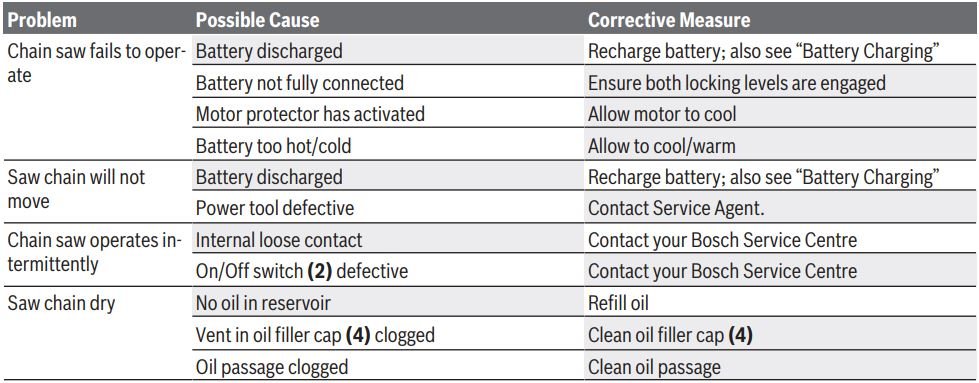
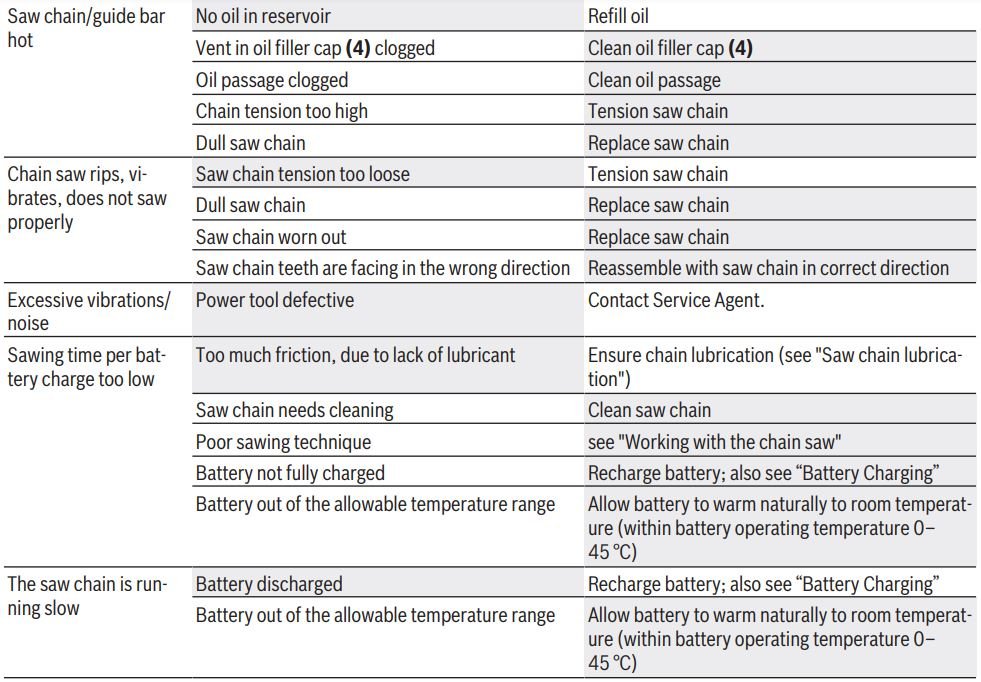
Battery and charger
Maintenance and Service
Maintenance and Cleaning
- Before any work on the garden product itself (e. g. maintenance, tool change, etc.) as well as during transport and storage, remove the battery from the garden product. There is danger of injury when unintentionally actuating the On/Off switch.
Note: To ensure long and reliable service, carry out the following maintenance regularly.
For safe and proper working, always keep the power tool and its ventilation slots clean. Regularly check the chain saw for obvious defects such as loose, dislodged or damaged saw chain and chain bar, loose fixings and worn or damaged components.
Check that covers and guards are undamaged and correctly fitted. Carry out necessary maintenance or repairs before using. Regularly check the chain saw for obvious defects such as loose, dislodged or damaged saw chain and chain bar, loose fixings and worn or damaged components.
Note: Before returning the chain saw, ensure all oil in the oil reservoir has been emptied. Ensure that the oil reservoir is refilled before using the chain saw again.
Replacing/changing the saw chain and chain bar (see figures A1–A4)
- Use only original Bosch accessories.
Check the saw chain and chain bar according to section “Tensioning the Saw Chain”. Replace a worn chain bar.
Check the drive sprocket (20). If it is worn out or damaged due to strain, have it exchanged by an authorized Bosch after-sales service.
Sharpening the Saw Chain
Never sharpen the saw chain yourself unless you have experience with it. Replace the saw chain with replacement saw chain (F 016 800 489) or have the saw chain professionally reground at your authorised customer services agent for Bosch power tools.
Checking the Automatic Oiler
Proper functioning of the automatic saw chain oiler can be checked by running the chain saw and pointing the tip of the chain bar towards a piece of cardboard or paper on the ground. Do not touch the ground with the chain and ensure a safety clearance of 20 cm. If an increasing oil pattern developes, the automatic oiler is operating correctly. If there is no oil pattern despite a full oil reservoir, see section “Troubleshooting” or contact your authorized Bosch aftersales service.
After Use/Storage
Put the chain guard (9) on the bar (11) to prevent injury. The saw chain (12) can become blunt because of unwanted hits/scratches.
Remove the oil from the oil tank before storage.
Clean the moulded plastic housing of the chain saw using a soft brush and clean cloth. Do not use water, solvents or polishes. Remove all debris, especially from the motor cooling vents.
After 1–3 hours of use, remove the cover (15), the chain bar (11) and the saw chain (12), and clean them using a brush. Clean the area under the cover (15), the drive sprocket (20) and the chain bar assembly from adherant debris using a brush. Clean the oil outlet (21) with a clean cloth.
Note: Do not clean the area around the oil outlet (21) with a brush, as debris can be lodged into the automatic oiling system and can cause blockages and lubrication problems. Make sure that sawdust and dirt are removed and that the oil lines and the oil system can not be clogged up. If the chain saw is to be stored for a longer period of time, clean the saw chain (12) and the chain bar (11). Always store the chain saw with the chain guard (9) in a secure, dry place, out of the reach of children.
Do not place other objects on the chain saw.
Please take care to place down the chain saw with the oil filler cap (4) facing upward.
When storing in the sales packaging, the oil reservoir must be completely emptied.
Do not modify this product. Unauthorized modifications may impair the safety of your product and may result in increased noise and vibration.
Accessories
Saw chain
UniversalChain 18 F 016 800 489
Additional accessories
Saw chain oil, 1 litre 2 607 000 181
After-Sales Service and Application Service
Our after-sales service responds to your questions concerning maintenance and repair of your product as well as spare parts. You can find explosion drawings and information on spare parts at: www.bosch-pt.com
The Bosch product use advice team will be happy to help you with any questions about our products and their accessories.
In all correspondence and spare parts orders, please always include the 10‑digit article number given on the nameplate of the product.
Great Britain
Robert Bosch Ltd. (B.S.C.)
P.O. Box 98
Broadwater Park
North Orbital Road
Denham Uxbridge
UB 9 5HJ
At www.bosch-pt.co.uk you can order spare parts or arrange the collection of a product in need of servicing or repair.
Tel. Service: (0344) 7360109
E-Mail: [email protected]
You can find further service addresses at: www.bosch-pt.com/serviceaddresses
Transport
The contained lithium-ion batteries are subject to the Dangerous Goods Legislation requirements. The batteries are suitable for road-transport by the user without further restrictions.
When shipping by third parties (e.g.: by air transport or forwarding agency), special requirements on packaging and labelling must be observed. For preparation of the item being shipped, consulting an expert for hazardous material is required.
Dispatch battery packs only when the housing is undamaged. Tape or mask off open contacts and pack up the battery in such a manner that it cannot move around in the packaging. Please also observe the possibility of more detailed national regulations.
Disposal
 The product, batteries, accessories and packaging should be sorted for environmentalfriendly recycling.
The product, batteries, accessories and packaging should be sorted for environmentalfriendly recycling.
![]() Do not dispose of the product and batteries/rechargeable batteries into household waste!
Do not dispose of the product and batteries/rechargeable batteries into household waste!
Only for EU countries:
According to the European Guideline 2012/19/EU, products that are no longer usable, and according to the European Guideline 2006/66/EC, defective or used battery packs/ batteries, must be collected separately and disposed of in an environmentally correct manner.
Only for United Kingdom
According to Waste Electrical and Electronic Equipment Regulations 2013 (2013/3113) and the Waste Batteries and Accumulators Regulations 2009 (2009/890), power tools that are no longer usable must be collected separately and disposed of in an environmentally friendly manner.
Battery packs/batteries:
Li-ion:
Please observe the notes in the section on transport (see “Transport”, page 27).

Robert Bosch Power Tools GmbH
70538 Stuttgart
GERMANY
F 016 L94 153 (2021.06) O / 431

Download Manual PDF
BOSCH UniversalChain 18 User Manual PDF Download

 Protect the battery against heat (e.g., against continuous intense sunlight), fire, water, and moisture. There is a risk of explosion.
Protect the battery against heat (e.g., against continuous intense sunlight), fire, water, and moisture. There is a risk of explosion.
